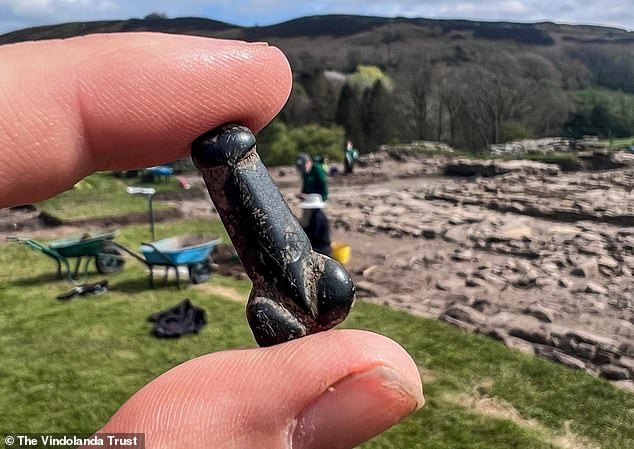Archaeologists have uncovered a ‘wonderful’ penis pendant at Vindolanda, the historic Roman fort in Northumberland.
Measuring less than an inch, the jet black charm was likely handcrafted in the fourth century AD, about 300 years after the Romans invaded Britain.
At Vindolanda, small, portable phalli made of bone or metal were commonly worn as pendants around the neck, to ward off evil and aid fertility.
According to experts, this particular object’s smooth surface suggests the owner touched it often for good luck.
Dr Andrew Birley, director of excavations at the Vindolanda Charitable Trust, called it a ‘wonderful little artefact’.
‘This little jet pendant was lost at sometime in the early 4th century when the barrack wall in which it was found was constructed,’ he said.
Vindolanda Charitable Trust posted the find to its Facebook page, where it was met with some hilarious comments.
‘Well, so much for size not mattering,’ one person said, while another posted: ‘That’s 6” honestly!’

According to experts, the object’s smooth surface suggests the owner touched it often for good luck
It was uncovered last Friday (April 25) by one of the volunteers joining Vindolanda Charitable Trust for ongoing excavations.
It is now at an on-site laboratory where it will be cleaned before going being researched further and going on public display at Vindolanda in 2026.
Just under an inch (2.5cm) in length, the phallic charm was constructed out of jet, a dark, semi-precious gemstone.
Jet became increasingly common as a material used for jewellery from the early third century onwards, according to Dr Birley.
‘Small good luck charms or pendants like these would have been worn by many of the soldiers at places like Vindolanda,’ he said.
‘I have no doubt that this is just the start of many more discoveries to come from Vindolanda this year.’
Vindolanda Roman Fort was under Roman occupation roughly between 85 AD and 370 AD, archaeological excavations already show.
We also know that phallic symbols were used widely across the Roman Empire as a way to protect against bad luck and ward off evil.

Just under an inch (2.5cm) in length, the phallic charm was constructed out of jet, a dark, semi-precious gemstone

This aerial view shows the historic Roman auxiliary fort of Vindolanda near Hadrian’s Wall in northern England
Small phalli carved from bone or crafted from metal were commonly worn as pedants, while homes were often decorated with frescoes or mosaics featuring phalli.
It’s not the first time phallic objects have been found at Vindolanda, which is also known for its collection of ancient writing tablets.
Back in 2023, researchers revealed a much larger artefact made of wood which may have been used for more than just warding off evil.
Both ends of this particular object were noticeably smoother, indicating ‘repeated contact over time’ possibly in a sexual context.
Alternatively, it may have been used as a pestle to grind ingredients for cosmetics or medicines.
Another possibility is it was slotted into a statue which passers-by would’ve touched for good luck or to absorb or get protection from misfortune – common throughout the Roman Empire.
Ancient Roman graffiti at Vindolanda also includes phallic engravings along with insulting text calling someone a ‘s***ter’.

In 2023, experts discovered a strange wooden artefact at the Roman fort of Vindolanda that they believe may have been used during sex

The object was found alongside dozens of shoes and dress accessories, which meant it was initally thought to be a darning tool. However, a new analysis suggests that the life-size object – measuring 6.3 inches long – was actually used as a sexual implement

Researchers discovered a large phallus and an inscription which brands a Roman soldier called Secundinus a ‘s***ter’ at the historic site, dating back 1,700 years
Previously, archaeologists found a handwritten birthday invitation at Vindolanda where one woman invited her ‘dearest sister’ to join her.
Today, Vindolanda is somewhat less famous than Hadrian’s Wall, the former defensive fortification begun in AD 122 during the reign of the Emperor Hadrian.
Although first built by the Roman army before Hadrian’s Wall, Vindolanda became the wall’s construction and garrison base.
Experts think Vindolanda was demolished and completely re-built no fewer than nine times, each rebuild leaving a distinctive mark on the landscape.
Vindolanda’s archaeological site and museum, which houses many of its discovered artefacts, is open to the public seven days a week.
This article was originally published by a www.dailymail.co.uk . Read the Original article here. .



